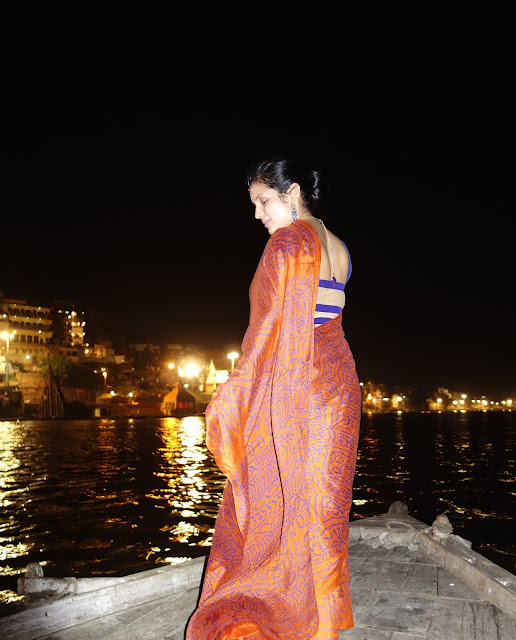I spent a week in Varanasi, Banaras. I absolutely loved the place. I promise to do a detailed blog post on Varanasi and things to see, shop, eat there, later. This blog post is more about the saree I wore the very first day there. It is a Bandhini saree which is more than a decade old. I paired it with a crop top/ blouse that I wore it with a skirt here and here earlier. I paired it with blue beaded necklace and earrings and blue bangles. Just a piece of advice, if you are travelling to Varanasi, avoid carrying real jewellery. Artificial jewellery will be fun to carry there and you will be safe.
The pictures were shot at Dasaswamedh ghat which is popular for its beautiful aarti that you see at night. We took a boat and went to see the aarti.
Every saree lover should have at least one cheerful Rajasthani bandhej saree.
Bandhej Silk sarees are from Rajasthan. The term ‘Bandhej’ or 'Bandhani' is derived from the word 'Bandhan' that means tying up. An ancient art practised mainly in the states of Rajasthan and Gujarat, the history of Bandhej Sarees backdates to pre-historic times. The women folk who are generally known to carry out the task of creating traditional bandhej sarees from one generation to another are involved in the art form that includes tying a cloth with millions of tiny knots and then immersing the cloth in various colors to dye it in such a way that when the cloth is dried and the knots are removed, the undyed portion of the cloth forms many interesting designs and patterns. A colourful tradition, Rajasthani Bandhej sarees are the very identity of the exuberant culture of Rajasthan.
From Rajasthan to Tamil Nadu, the handcrafted Bandhani sarees are famous all over the country. Owing to the linguistic variations across regions, the Bandhani sarees are also known as Bandhej, Bandhni, Piliya, Chungidi, Ghar Chola and Patori. Bandhani is a type of tie-and-dye technique that relies heavily on human skills. Bandhani is known for using bright colours.
The earliest evidence of Bandhani can be found during the Indus Valley Civilization. Closer home, evidence of Bandhani dots were found in 6th-century paintings of the life of Buddha on the walls of Ajanta Caves. These amazing patterns have since drawn many foreign visitors to India.
If historical records are to be believed, the first Bandhani saree was worn in a royal wedding during the time of Harshacharita. Bandhani technique was first started in India by the Khatri community of Gujarat, and the region is still synonymous with this form of art. Rajasthan is another state where this art is practised. Started on a small scale, Bandhani is a thriving industry today.
The earliest evidence of Bandhani can be found during the Indus Valley Civilization. Closer home, evidence of Bandhani dots were found in 6th-century paintings of the life of Buddha on the walls of Ajanta Caves. These amazing patterns have since drawn many foreign visitors to India.
If historical records are to be believed, the first Bandhani saree was worn in a royal wedding during the time of Harshacharita. Bandhani technique was first started in India by the Khatri community of Gujarat, and the region is still synonymous with this form of art. Rajasthan is another state where this art is practised. Started on a small scale, Bandhani is a thriving industry today.
The making of Bandhani sarees is a process worth watching. Travellers and tourists from different parts of the world visit Bandhani saree production centres, not only with the aim to buy them but also to marvel at the ingenious process. At first, the fabric is tied tightly with a thread at various points and then dipped into a bucket of natural dye. This technique creates amazing patterns on the fabrics.
Bandhini sarees are beautiful expressions of a community which constantly struggles against water scarcity. Perhaps, this is the reason monsoons bring out the best in the artisans, watering not just their throats but their parched imagination too. Monsoon inspired Bandhini sarees are simply gorgeous, as they beautifully embody the flow and grace of water and rains.
Originally found in the parts of Rajasthan and Gujarat, Bandhani sarees are a sensation across the globe.
Bandhini sarees are beautiful expressions of a community which constantly struggles against water scarcity. Perhaps, this is the reason monsoons bring out the best in the artisans, watering not just their throats but their parched imagination too. Monsoon inspired Bandhini sarees are simply gorgeous, as they beautifully embody the flow and grace of water and rains.
Originally found in the parts of Rajasthan and Gujarat, Bandhani sarees are a sensation across the globe.



















No comments:
Post a Comment